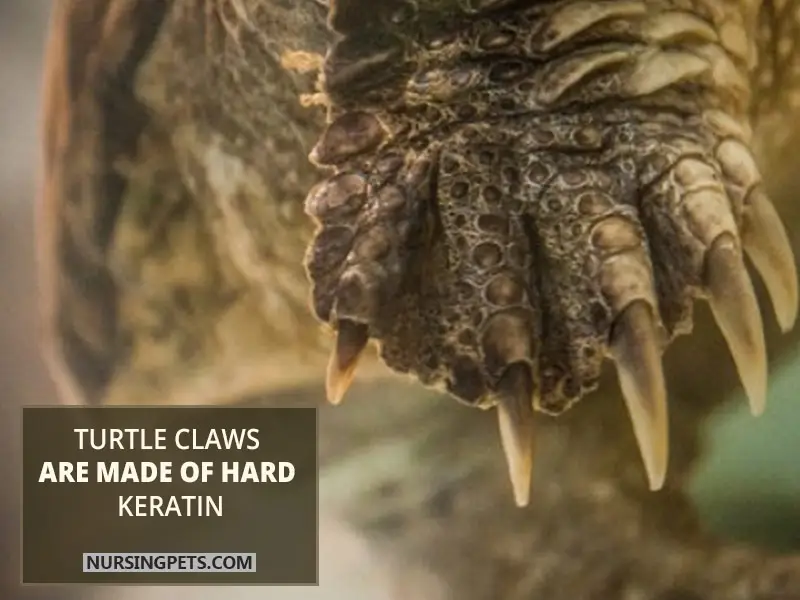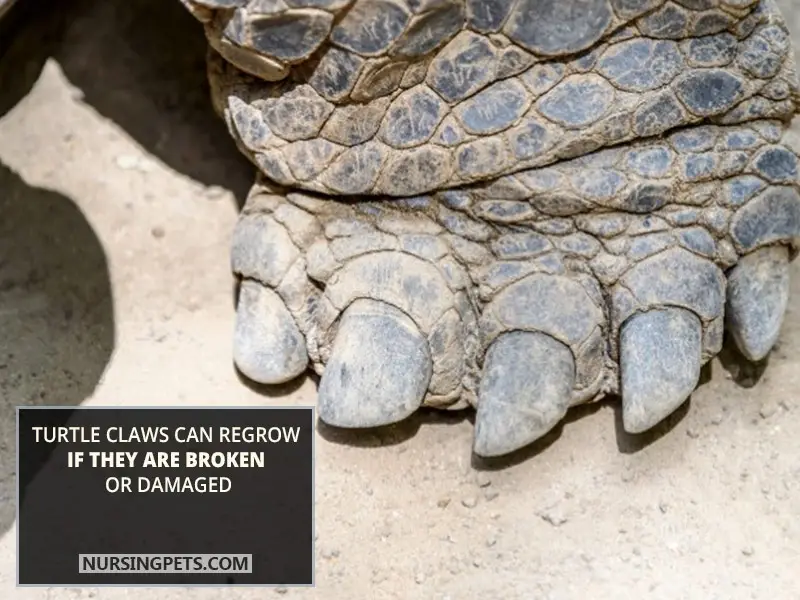Do Turtles Have Claws?
Claws are typically associated with terrestrial animals and are used for various purposes, such as digging, climbing, or hunting. And when we think of claws, images of animals like lions and bears may come to mind. But what about turtles? Do turtles have claws?
Yes, turtles do indeed have claws or nails (both used interchangeably). However, the size, purpose, and even the presence of claws may vary among different turtle species. And claws in turtles serve various functions that align with their specific behaviors and needs. Commonly, turtles utilize their claws for activities such as digging, nesting, walking, and mating rather than fighting.
Now, let’s dive into the details of the wondrous anatomy of these remarkable creatures and uncover all the mysteries about this topic. So, get started.
Looking for more articles about turtles:
Turtle Claw/Nails
As we have mentioned, turtles do possess claws or nails. Although, the size, location, and functionality of these claws can vary among different species of turtles. And they serve various purposes depending on the specific needs, environment, and behaviors of the species.

The claws of turtles are composed of hard keratin (similar to our nails), the same protein that makes up the outer layer of their shells. And they can grow back when damaged or broken.
Male Vs. Female Differences in Claw Characteristics
Front flipper Claws on females are usually short and stubby. On the other hand, male turtles have strong and longer claws, especially red-eared sliders, sea turtles, and other aquatic ones.
Adult male turtles may use their claws to help grasp females during mating. Also, male turtles use their claws to entice or tempt female turtles to breed.
So, do all male turtles have long claws? Well, in general, male turtles have longer claws than the females. And some male aquatic turtle species, like the red-eared slider, may have noticeably longer claws on their front legs.
However, not all turtle species exhibit such clear differences in claw length between males and females.
Sea Turtle Claws
Do Sea Turtles Have Claws? Yes, sea turtles do have claws. The number of claws on each flipper varies depending on the species of sea turtle. And they usually have two claws on their front flippers, while the back flippers usually have none.

These claws serve specific purposes related to activities like digging, gripping, and climbing. Additionally, the fore flippers claws on the male sea turtle (except leatherbacks) are elongated and curved, which may help them grasp a female’s shell during mating.
However, despite their functionality, sea turtles can still do fine even without nails which are not essential for their survival.
Possible Number of Claws of Sea Turtles
There are seven species of sea turtles. Each species belongs to a different class of turtles and has unique physical and behavioral characteristics. However, all of them don’t have claws.
Check this table to find out different species of sea turtles and their usual number of claws:
| Species | Number of Claws |
|---|---|
| Flatback sea turtles | 1-2 claws on front flippers |
| Green sea turtles | 1-2 claws on front flippers |
| Hawksbill sea turtles | 2-4 claws on front flippers |
| Loggerhead sea turtles | 2-5 claws on front flippers |
| Kemp’s ridley sea turtles | 1-3 claws on front flippers |
| Olive ridley sea turtles | 1-3 claws on front flippers |
| Leatherback Sea Turtles | No Claws |
Do Leatherback Sea Turtles Have Claws?
The leatherback is the largest sea turtle in the world. But unfortunately, as mentioned, leatherback sea turtles don’t have claws. Instead, they’ve four large flippers used for propulsion to help them swim.

Since the leatherback turtle doesn’t have claws, it relies on its jaws and beak to trap and hold prey. Their flippers are highly adapted, which increases their speed and maneuverability in the ocean and enables them to dig nests on beaches.
Land/ Freshwater/ Terrestrial/Semi-Aquatic Turtle Claws
Yes, they also possess claws or nails. Land-dwelling turtles, such as box turtles, have front and back claws. Moreover, freshwater, terrestrial, and semi-aquatic turtles’ claws can vary in size, shape, and functionality.
And they are usually sharp and curved and well-adapted for digging, swimming, defense, and climbing.
Let’s take a look at these turtle species’ claws’ usual characteristics:
Freshwater Turtle Claws:
- Freshwater turtles typically have relatively short and blunt claws.
- Their claws are not as long or sharp as those of some land-dwelling species.
- These claws are good for gripping and climbing on surfaces such as rocks, logs, or vegetation in their aquatic habitats.
- Help them navigate through their environment and provide stability while basking or moving on land.

Terrestrial/Land Turtle Claws:
- Terrestrial turtles have claws that are generally thicker and more robust compared to freshwater turtles.
- The claws of terrestrial turtles are adapted for digging and moving on land.
- They can have strong, slightly curved claws that aid in burrowing into the ground and excavating nests.
- These claws are essential for their terrestrial activities, such as foraging, nesting, and defense.
Semi-Aquatic Turtle Claws:
- Semi-aquatic turtles possess claws that serve a dual purpose for both land and water.
- Their claws are typically intermediate in length and shape between freshwater and terrestrial turtles.
- They may have partially webbed feet with claws, allowing them to swim efficiently and providing traction on land.
- The claws of semi-aquatic turtles help them navigate various environments, from swimming in water to walking on different types of surfaces.
As mentioned, specific characteristics of claws can vary among different species of turtles, and there may be exceptions to these generalizations.
Functions of Turtle Claws
Why do turtles have claws? The claws of turtles, in general, have evolved to serve a variety of purposes depending on their need and environment.

So, not all species use their claws for the same reasons. But their usual or common functions are:
01. Defense/ Protection/ Scratching
Although turtle claws aren’t meant for fighting, or they usually don’t use them for defense, turtles can retract their limbs into their protective shells, and their claws serve as a deterrent to potential predators.
And when threatened, turtles can extend their limbs and use their sharp claws or nails for scratching, providing them with a means of defense.
02. Digging/Nesting
Many turtles have strong claws that are well-suited for digging. They use their claws to excavate nests for laying eggs. Also, the claws help them to loosen the soil or sand and create a suitable environment for their eggs.
Additionally, some turtles also dig burrows in which they can find refuge or hibernate during unfavorable conditions.
03. Climbing
Certain turtle species are skilled climbers, and their claws aid in this ability. Arboreal turtles, such as box turtles, possess sharp, curved claws that allow them to grip onto tree trunks and branches, enabling them to navigate through their arboreal habitats.
04. Feeding
Some turtles use the help of their claws to capture and manipulate food. Aquatic turtles, like snapping turtles, have sharp claws on their front limbs, which they use to grab and hold onto prey such as fish or small invertebrates. These claws assist in securing their food before they consume it.

05. Swimming
Turtles are not known for their speed in the water, but their claws do contribute to their swimming ability. Aquatic turtles have partially webbed feet with claws that aid in propelling themselves through the water. The claws provide traction and assist in maneuvering as they swim.
06. Mating
During mating, male turtles often use their claws to grasp onto the female’s shell or limbs, especially the sea turtles. The claws help them maintain a firm grip during copulation, ensuring successful reproduction.
07. Balance and Stability
Turtles with long claws can utilize them for balancing and maintaining stability. In terrestrial species, the claws provide additional support when walking or climbing over uneven terrain, preventing slips or falls.
Again, specific functions and adaptations of turtle claws can vary depending on the species and their ecological niche.
Can Turtles Retract Their Claws?
A retractable claw is a specialized adaptation that allows one to retract claws whenever needed. However, turtles do not possess retractable claws. Instead, turtles have claws that are fixed and extend beyond the tips of their toes.

And in the case of sea turtles, this phenomenon is also the same. Due to their unique anatomic structure, sea turtle can’t retract their claws.
Do Turtle Claws Grow Back
Turtle claws do grow back if they are broken or lost. In the wild, a turtle’s nails can naturally wear down or break during different activities.
When a turtle loses a claw, it’ll slowly grow a new one. This process typically takes several months, and the new claw will grow as strong and functional as the original.

However, the regeneration of claws depends on several factors, like age and food. It takes longer to regrow if claws are badly damaged or lost due to a disease or infection. And in some cases, the growth may be stunted or deformed.
Additionally, wild turtles experience regular wear and tear on their claws, minimizing the chance of overgrowing. However, a captive turtle may need occasional trimming to keep their claws or nails in check (twice a year is enough).
Frequently Asked Questions
01. Do All Turtles Have Nails or Claws?
All turtles have nails or claws (except Leatherback sea turtles), but their length, strength, and function can differ according to their species, as mentioned previously. And sea turtles, however, do not necessarily have nails. They possess claws on their front flippers.
02. Are Sea Turtles Born With Claws?
Sea turtles aren’t born with claws. During their incubation period, sea turtle embryos do not develop claws. At the age of 2-3, their claws started to grow and form. However, female claws grow slower than males.
03. Do snapping turtles have claws?
Snapping turtles have large and sharp claws, more like grizzly bears. They use them for digging, gripping, and foraging. However, snapping turtles don’t or can’t use their claws for attacking or eating because of their slow speed and swiping strength.
04. Do box turtles have claws?
Yes, box turtles have claws. In general, males possess short, thick, and curved hind claws, while females exhibit contrasting features, which are long, straight, and slender. And their usual functions are digging, climbing, and gripping surfaces.
Parting Words
In a nutshell, turtles do have claws, although the presence and size of claws can vary among different turtle species. And they serve various purposes for turtles, such as digging, climbing, gripping surfaces, and even assisting in mating behavior for some species.
However, their nails or claws are not as sharp or prominent as those of other animals but are adapted to suit their needs and environment.
Article References:
- Why do sea turtles have claws? – New England Aquarium (neaq.org)
- Sea Turtles Facts and Information | SeaWorld Parks & Entertainment
- Olive Ridley Sea Turtle | National Wildlife Federation (nwf.org)
- Sea Turtle | Species | WWF (worldwildlife.org)
- The 7 Species of Sea Turtles (thoughtco.com)
- 7 species of sea turtles – Institut océanographique (oceano.org)
Image Sources:
- Canva.com/photos
- Stock.adobe
- Neaq.org

